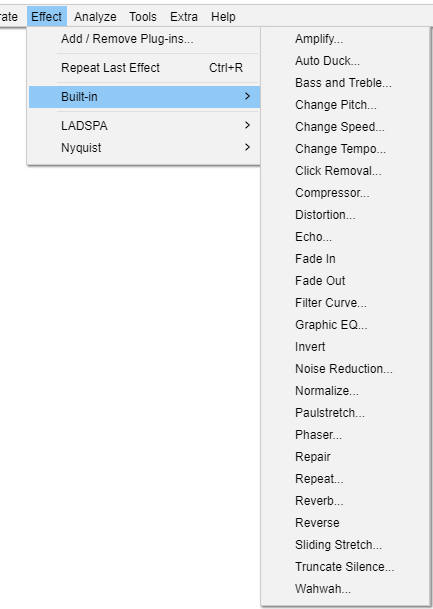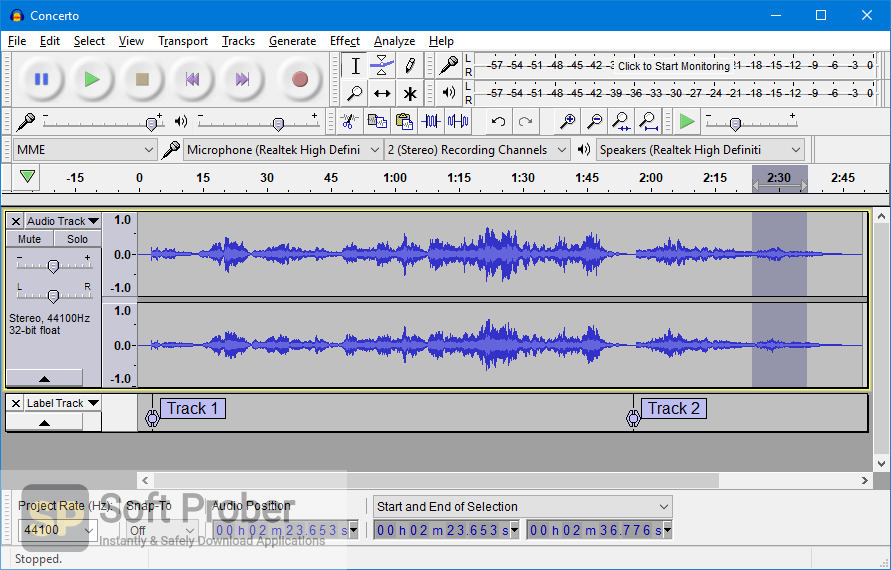

The controls will now have been adjusted according to the selected preset.

In the "Presets" panel, click the Load button, select Vocal II from the list then click OK. Select the audio track that contains the vocal recording.Ĭlick Effect Reverb to launch the Reverb effect. If necessary, add a few seconds of silence to the end of the track (see steps 1.1 to 1.4 in the example below). Otherwise, Vocal I creates a softer, less obvious reverb.Įnsure that there is a few seconds of silence at the end of the audio so that the final note can fade away naturally. This technique habits the built-in preset Vocal II. Comparing the "Dry Preview" and "Preview" results reveals a before and after comparison.Īpply a rich and bright reverb to a "dry" vocal recording. Previews what the result would sound like if the current settings are applied.ĭry Preview: Previews the novel audio selection completely, just like playing that selection in the main window. Defaults settings are similar to the screenshot above. You are able to save your favorite settings in the Settings0 to Settings9, until you saved your settings in one of these slots, the default settings will load into you effect. Wet Only may be used on the other hand to produce a "reverb only" track allowing you to be able to then combine in larger or smaller amount with the novel track.Ĭlick this button to load one of nine fixed presets:Īfter deciding on the preset that is best suited for what you require, click OK, the settings for the selected preset with be loaded into the effect you want. This can be beneficial when reviewing the result, but in most circumstances, you should uncheck this when adjusting the effect. Wet Only: Indicating this regulator, only the wet indicator (additional reverberation) will be in the subsequent output, and the novel audio will be impassive. If set at nil, the result is applied autonomously to left and right channels. Growing this value contribute more deviation concerning left and right channels, generating a more roomy result. Stereo Width (%): Sets the superficial width of the Reverb outcome for stereophonic tracks only. When the Wet Gain and Dry Gain values are similar, then the combination of wet effect and dry audio to be produced to the track will be made louder or softer by precisely this value (supposing "Wet Only" is not patterned).

Accumulating this value in relation to the "Wet Gain" decreases the power of the reverb. Accumulating this value in relation to the "Dry Gain" intensifies the power of the reverb.ĭry Gain (dB): Relates to the volume fine-tuning to the novel ("dry") audio in the mix. Wet Gain (dB): Relates to the volume fine-tuning to the reverberation ("wet") factor in the mix. Tone High (%): Adjusting this controller below 100% decreases the high frequency constituents of the reverberation, producing a lesser amount of perkiness as a result. Tone Low (%): Adjusting this controller lower than 100% decreases the low frequency constituents of the reverberation, fashioning a lesser amount of roominess as a result. Mimics the captivation of high frequencies in the reverberation. The reverberation does not shape up as considerable, and the high frequencies deteriorate quicker than the low frequencies. For any particular reverberance value, the tail will be bigger for loftier room sizes.ĭamping (%): Cumulating the damping creates an added hushed result. This regulates how long the reverberation endures for once the original sound being reverbed stop, and so mimics the energy of the room auditory range. Reverberance (%): Sets the interval of the reverberation tail. Cautious regulation of this parameter can increase the clearness of the result. The maximum pre-delay is 200 milliseconds. It delays the commencement of the reverb tail as well. Pre-delay (ms): Postpones the commencement of the reverberation for the fixed time subsequently to the start of the original input. A high value will mimic the reverberation result of a large area and a low value will mimic the result of a small room. 0% is like a closet, 100% is like a huge church or large lecture hall. Room Size (%): Sets the size of the computer-generated room.


 0 kommentar(er)
0 kommentar(er)
